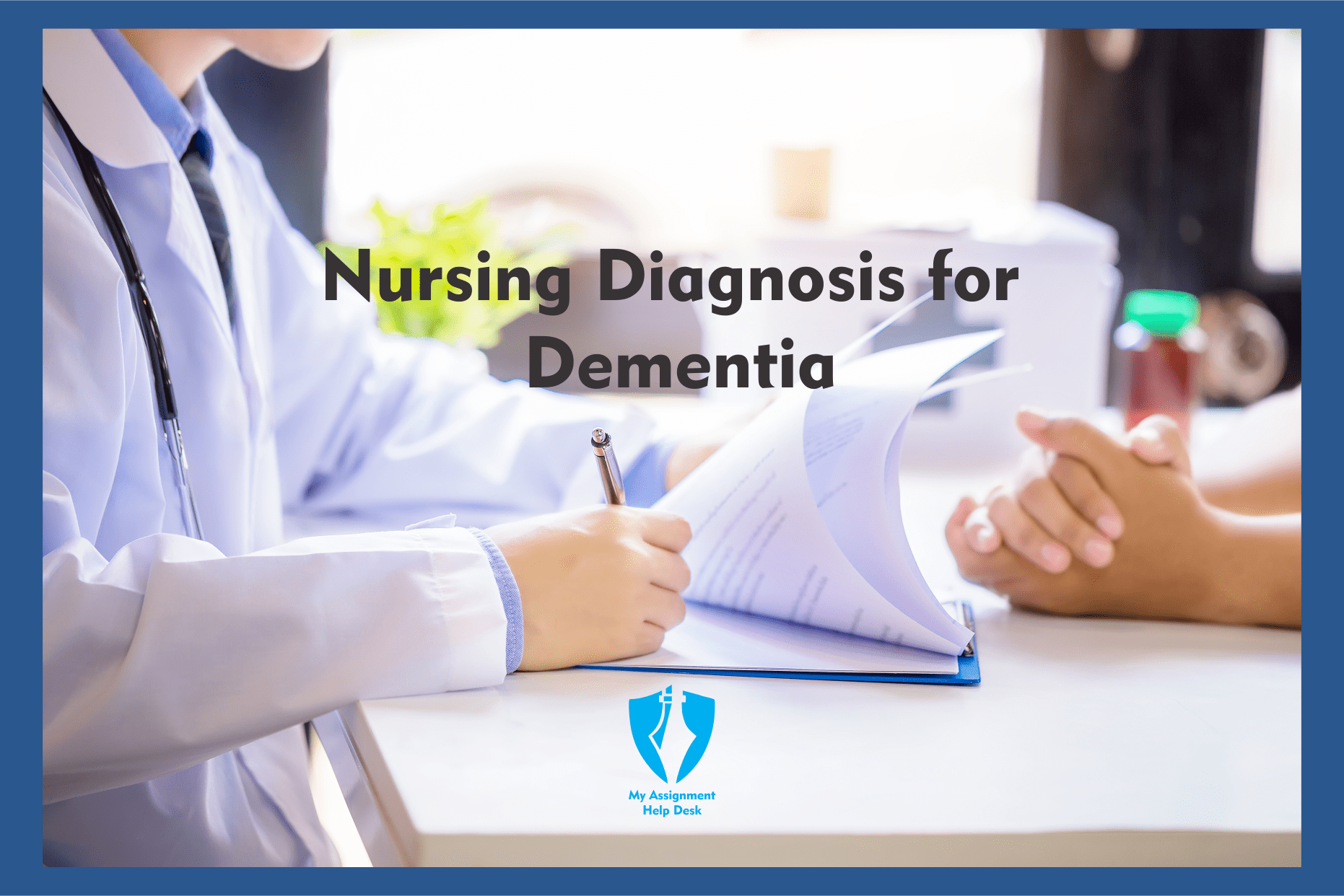Nursing Diagnosis for Dementia
In Your nursing career, you may encounter patients suffering from different brain disorders, including dementia. Dementia is a broad term that covers a range of chronic diseases that affect the brain and have various causative factors. It is defined as a loss of cognition, full memory function, and is commonly exhibited by a lack of cull alertness.
Currently, there are about four clinical dementia syndromes that account for about 90% of the cases recorded. Alzheimer’s disease is a significant contributor to dementia, with over 47 million cases filed in 2015, and 75 million people expected in 2030. This article explains what is expected of the nurse during the diagnosis process for the dementia patient.
Table of Contents
What are the Causes of Dementia?
Dementia could be caused by different factors, some of which are predisposing effects that ultimately lead to a brain disorder. The first type of dementia is caused by Alzheimer’s disease, which leads to a decline in the brain acetylcholine and subsequently head trauma. Vascular dementia is caused by cerebrovascular disease, which is equivalent to strokes in the arteries. Dementia is also common for HIV patients due to the immune dysfunction that may occasion brain infection.
Dementia could be caused by head trauma, a syndrome of symptoms that are associated with a traumatic head injury. Other causative factors include different diseases such as Lew’s body disease, Parkinson’s disease, Huntington’s disease, pick a condition, and Creutzfeldt-Jakob disease. More importantly, dementia could be substance-induced for users of alcohol, inhalants, and hypotonic.
What are the Defining characteristics of dementia?
For you to diagnose this disease, you need to understand its signs and symptoms. There could be some differences in the signs and symptoms, but they commonly exhibit some common behaviors:
- Being too forgetful to an extent, they even get lost in the neighbourhood.
- They use unusual words, which indicate that their brain is not functioning normally.
- The patient exhibits confusion and forgetfulness.
- In most patients, they lose the ability to work independently.
- There are changes in mood, and some patient becomes too repetitive.
The signs are commonly manifested due to the change in brain functionality.
Goals and Outcome of Nursing Diagnosis for Dementia
The nurse should diagnose the patient to improve the patient’s condition and enhance his brain functionality. One goal is for Dementia patients to record an improvement as exhibited through an accurate interpretation of the environment. Secondly, a nursing diagnosis is also set to improve the assistance of the caregiver by allowing the client to interrupt his/her thinking.
A key outcome from the diagnosis is the enforcement of the patient’s brain in a manner that enables them to think and behave appropriately. Finally, it is the goal of the nursing diagnosis to help in the improvement of the patient through a nursing diagnosis that enables them to get thoroughly familiar with the objects and environment.
Nursing Assessment
As part of the diagnosis for patients with dementia, assessment is essential. There is a different assessment that helps to discern the type of dementia the patient is suffering from, the cause, and hence contributes to defining the possible intervention.
Psychiatric Interview
One primary assessment that the nurse should undertake in a dementia patient is the psychiatric evaluation. This is done through a psychiatric interview, which should indicate the mental status of the patient, his/her behaviour, and the flow of thought.
The psychiatric interview should also encompass an evaluation of the client’s ability to make a coherent speech, thought processing, and mental content. A psychiatric interview should also give an insight into the cognitive status, judgment, and ability of intellectual resources.
Serial Assessment
A serial assessment entails the psychiatric determination to establish the nature of brain fluctuations. The nurse conducts the continual assessment by interviewing family members to hear of their views regarding the mental status of the patient. This assessment is undertaken serially because family members have a close encounter with the patient.
From the serial assessment, the family members share the behaviour of the patient, which gives greater insight into the mental state that may not be established from mere observation. Serial assessment may also help to determine whether there could be other health problems that the patient could have suffered in the past.
Depression Assessment
Depression is a common sign among dementia patients, especially among older people. This is manifested through confusion as well as the uncharacteristic behaviour of the patient. To determine the level of patient depression, a Geriatric Depression Scale is recommended. This assessment strategy uses a ten questionnaire that covers issues that indicate the confusion induced by depression.
Questions that are asked in the Geriatric Depression scale are directed towards the patient, while also assessing the attitude during the response. Some of the issues that should be included in this are: are you satisfied with your life? Are you happy most of the time? Any patient that is noted to be depressed should be provided with counselling or medication.
Mini-Mental State Examination (MMSE)
A formal nursing diagnosis of dementia should include the use of the cognitive assessment tool, which is a 30-question (MMSE). The MMSE provides the patients with simple questions that need answers or solve problems in diverse areas.
The questions could cover a range of issues such as time, place, simple computations, language use, or any basic motor skills. For instance, the nurse may ask the patient to repeat a simple phrase or name an object. This test is an assessment of cognitive ability. MMSE is conducted since cognitive ability may decline due to conditions such as dementia. The nurse should act to provide an appropriate intervention if the cognitive ability has declined.
Confusion Assessment Method (CAM) Diagnosis
CAM is a standardized method that enables nurses and other non-psychiatric health professionals to identify the delirium behaviour of the patient quickly and accurately. Therefore, nurses should use this method in the diagnosis of dementia patients to tell whether the patient is hallucinating or exhibiting any other signs that amount to delirium.
CAM is considered a powerful tool that can be used in a clinical setting as well as during medical studies. It has four features that help to distinguish delirium from any other cognitive impairment. It is also used to detect the severity of the delirium.
Summary
Dementia is a condition defined by a loss of cognition, and full memory function, and is commonly exhibited by a lack of full alertness. There are three broad types of dementia: vascular dementia, Alzheimer’s disease-based, and HIV induced. In the nursing diagnosis of dementia, the following assessment methods should be applied:
- Psychiatric interview
- Serial Assessment
- Serial Assessment
- Depression assessment
- Mini-Mental State Examination (MMSE)
- Confusion Assessment Method (CAM) Diagnosis
The intervention method is majorly influenced by the diagnosis outcome.
References
- Littlejohns, T. J., Henley, W. E., Lang, I. A., Annweiler, C., Beauchet, O., Chaves, P. H., … & Lopez, O. L. (2014). Vitamin D and the risk of dementia and Alzheimer disease. Neurology, 83(10), 920-928.
- Alzheimer Disease international (2015). World Alzheimer Report 2015 . Retrieved from https://www.alz.co.uk/research/WorldAlzheimerReport2015.pdf
- Barnes, R. F., & Raskind, M. A. (1981). DSM-III criteria and the clinical diagnosis of dementia: a nursing home study. Journal of Gerontology, 36(1), 20-27.
- Carpenito-Moyet, L. J. (2006). Handbook of nursing diagnosis. NY: Lippincott Williams & Wilkins.
- Ackley, B. J., & Ladwig, G. B. (2010). Nursing Diagnosis Handbook-E-Book: An Evidence-Based Guide to Planning Care. Missouri: Elsevier Health Sciences.
- Johnson, J., Sims, R., & Gottlieb, G. (1994). Differential diagnosis of dementia, delirium and depression. Drugs & aging, 5(6), 431-445.
- Gordon, M. (2014). Manual of nursing diagnosis. NY: Jones & Bartlett Publishers.




